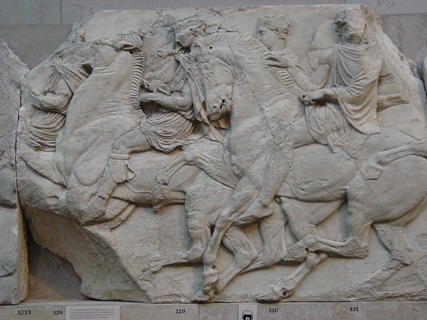“Cold as the crags upon his native coast, / His mind as barren and his heart as hard, / Is he whose head conceiv’d, whose hand prepar’d, / Aught to displace Athena’s poor remains.” Byron’s account of Thomas Bruce, seventh Earl of Elgin, offers a poetically abbreviated albeit violently subjective version of the story of the Elgin Marbles – which seemingly remain as controversial as ever, a full two centuries after Elgin acquired them.
Byron’s ire was roused by what remains perhaps the most extensive act of cultural appropriation in modern history. Between 1801 and 1811, Elgin’s agents in Greece removed approximately half of the sculpture to have survived from the great fifth-century BC temple of Athena known as the Parthenon, set high above Athens on the rock of the Acropolis. After many trials and tribulations – several tons of sculpture were lost at sea between Athens and England and spent two years underwater before being salvaged – this astonishing mass of antique sculpture eventually reached London. Elgin, who had effectively bankrupted himself by acquiring and transporting his marbles, eventually sold them to the Trustees of the British Museum for what now looks like the knockdown price of £35,000. That is around £1.5 million in modern money, which these days is apparently only enough to buy a few square inches of a Picasso.
 The Elgin Marbles can still be seen at the British Museum, forming what is perhaps its single greatest treasure. They comprise more than 75 metres of the great sculpted frieze that once ran around the inside of the entire Parthenon; plus 15 of the 92 sculpted panels, or “metopes” which once decorated its outside, occupying the spaces above its columns, depicting men defeating centaurs, Greeks defeating Amazons and other subjects allegorising the triumph of Athenian civilisation over...
The Elgin Marbles can still be seen at the British Museum, forming what is perhaps its single greatest treasure. They comprise more than 75 metres of the great sculpted frieze that once ran around the inside of the entire Parthenon; plus 15 of the 92 sculpted panels, or “metopes” which once decorated its outside, occupying the spaces above its columns, depicting men defeating centaurs, Greeks defeating Amazons and other subjects allegorising the triumph of Athenian civilisation over...

The Elgin Marbles - The Essential History Everyone Should Know Before Sounding Off
20-06-2004

